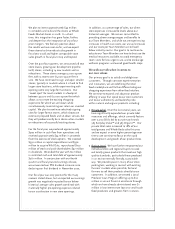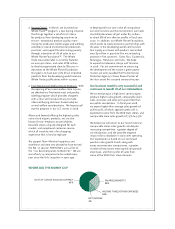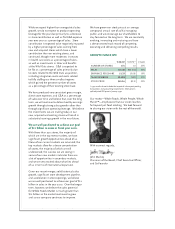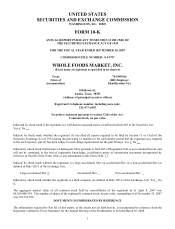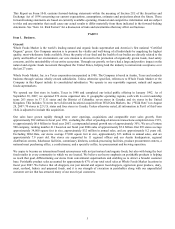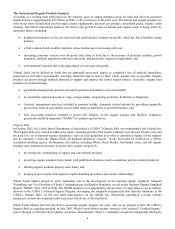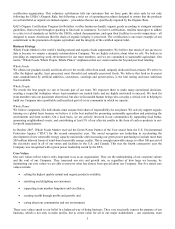Whole Foods 2007 Annual Report Download - page 14
Download and view the complete annual report
Please find page 14 of the 2007 Whole Foods annual report below. You can navigate through the pages in the report by either clicking on the pages listed below, or by using the keyword search tool below to find specific information within the annual report. 8
produce, dairy, meat, seafood, bakery and prepared foods. We believe it is our strength of execution in perishables that has
attracted many of our most loyal customers.
Locally Grown
Our history and reputation are intimately linked to our support of local farmers. For more than 27 years, we have provided
our customers with the broadest possible selection of the highest quality produce available. Our search for produce begins
right outside our front door in every community where we do business. We are committed to buying from local producers
whose products meet our high quality standards, particularly those who are dedicated to environmentally friendly,
sustainable agriculture. We are greatly increasing our efforts in this regard by further empowering our individual store and
regional buyers to seek out locally grown products. We value this natural diversity and have firm guidelines for using the
term “local” in our stores. For example, only produce that has traveled less than seven hours from the farm to our facility can
be labeled “locally grown.”
Whole Foods Market currently purchases produce from over 3,000 different farms through various suppliers. Of the
Company’s top 10 produce suppliers, eight represent independent farms with privately held ownership. We believe we can
and should do more to support local producers. To that end, we have established a budget of up to $10 million annually to
promote local agriculture, especially animal agriculture, wherever we have stores through long-term loans at low interest
rates. We completed our first loan through the Local Producer Loan Program in February 2007 and so far have disbursed
more than $1 million in loans to over 20 local producers in nine of our 11 regions. Loan recipients must use funds for
expansion and not operating expenses, meet Whole Foods Market’s quality standards, and have a viable business plan and
adequate cash flow to service the debt. Eligible products include agricultural crops, value-added food products, and other all-
natural grocery items.
In addition, at stores in five of our 11 regions, we are now providing space in our parking lots weekly for local farmers to sell
their products directly to our customers, working in concert with existing farmers’ markets when possible. Our stores have
excellent locations and heavy customer traffic to help these farmers’ markets flourish, and their presence at our stores
provides more local choices for our customers.
Whole TradeTM
On March 29, 2007, we launched our Whole Trade program, a new buying initiative that brings together a set of strict
criteria for products from developing countries to ensure: exceptional product quality; more money for producers; better
wages and working conditions for workers; sound environmental production practices, and support of poverty eradication via
donating 1% of product sales to the Whole Planet Foundation.
The Whole Trade program gives low-income producers entry into and stability within the global marketplace by ensuring
better wages and safer working conditions for workers. It supports equitable systems of trade that are an investment in both
farms and communities. Through the Whole Trade program, Whole Foods Market seeks out and promotes foods that are
grown using sound environmental practices that encourage biodiversity and healthy soils. In addition to including some
products that are grown organically, the Whole Trade program includes products that respect the earth without formal
organic certification. These products could be sourced in two ways. Some come from farms that use integrated pest
management systems, emphasizing alternatives to chemical use; they also practice soil and water conservation through
composting and reforestation. Other products are respectfully harvested from land or water areas that provide shelter and
habitat for migratory birds and other species.
Our Whole Trade Guarantee label is currently featured on more than 400 items, and sales of nearly $8 million to date have
generated approximately $80,000 for the Whole Planet Foundation. Our goal is to have more than 50% of our imported
products from developing countries meet Whole Trade qualifications within 10 years.
Private Label
An extension of our leadership position in the natural and organic foods industry is our strong family of private label brands.
These products extend the confidence and trust our customers have in our stores to their everyday lives. We’ve built upon
this trust and over the last several years have significantly expanded our private label resources and offerings, which
currently feature over 2,000 SKUs led by our primary brands, 365 Everyday Value and 365 Organic.


